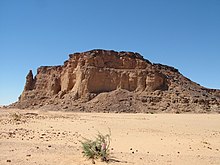The Sudans
This article possibly contains original research. (January 2021) |

The Sudans (also known as the two Sudans or just Sudan)
Geography

The Sudans are situated in northern/northeastern Africa, with a 853 km (530 mi) coastline bordering the
.The
The
The amount of rainfall increases towards the south. In the north there is the very dry Nubian Desert; in the south there are grasslands and tropical savanna. The Sudans’ rainy season lasts for about four months (June to September) in the north, and up to six months (May to October) in the south. The dry regions are plagued by sandstorms, known as haboob, which can completely block out the Sun. In the northern and western semi-desert areas, people rely on the scant rainfall for basic agriculture and many are nomadic, travelling with their herds of sheep and camels. Nearer the River Nile, there are well-irrigated farms growing cash crops.
There are several dams on the Blue and White Niles. Among them are the
Rich mineral resources are available in the Sudans including:
Desertification is a serious problem in the Sudans. There is also concern over soil erosion. Agricultural expansion, both public and private, has proceeded without conservation measures. The consequences have manifested themselves in the form of deforestation, soil desiccation, and the lowering of soil fertility and the water table.[5]

The nation's wildlife is threatened by hunting. As of 2001, twenty-one
In May 2007, it was announced that hundreds of wild elephants had been located on a previously unknown, treeless island in the Sudd swampland region of (then) southern Sudan. The exact location was being kept secret to protect the animals from poachers.[7]
See also
References
- ^ Kron, Josh (May 10, 2012). "In 2 Sudans, Familiarity With Path to War (Published 2012)" – via NYTimes.com.
- ^ "Big fight over a small place". October 26, 2013 – via The Economist.
- ^ "Largest Countries in the World". worldometer. Retrieved 1 December 2023.
- ^ "Country Studies". Country Studies. Retrieved 26 June 2010.
- ^ "Dept of Forestry, University of Khartoum". Unu.edu. Retrieved 26 June 2010.
- ^ [unreliable source?] Staff writer (n.d.). "Sudan — Environment". Encyclopedia of the Nations. Retrieved 13 January 2011.
- ^ Wheeler, Skye (28 May 2007). "Elephant Herds Found on Isolated South Sudan Island". Reuters. Retrieved 13 January 2011.
